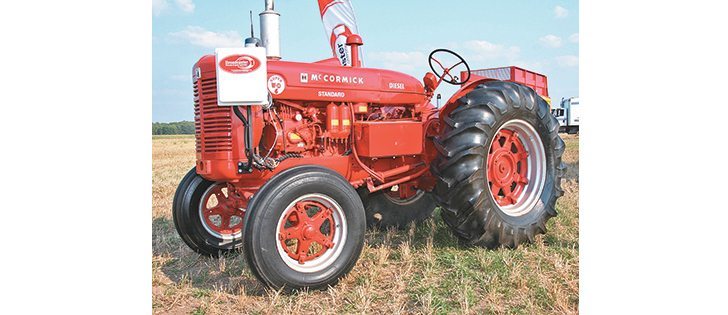Labour saving | Look ma, no person
GUELPH, Ont. — Farmers are forced to employ more remote control diesel engines as manpower becomes a larger limiting factor.
They are putting remote control diesel power on grain augers in the yard, irrigation pumps in the field, agitation and aeration pumps for liquid slurry, pumps to de-water flooded low areas and pumps to bring fresh water to dugouts for livestock and cisterns for people. The list goes on.
For the most part, those are modern diesel engines managed by new engine control unit (ECU) technology that is compliant with CAN BUS Tier 4 or T4i emission standards.
Read Also

Organic farmers urged to make better use of trade deals
Organic growers should be singing CUSMA’s praises, according to the Canadian Chamber of Commerce.
Tier 4 requirements not only clean up diesel exhaust but also provide standardized criteria for engine management that is almost universal. Tier 4 makes it easier for aftermarket software developers to tap into an engine control system with the idea of modifying it to meet the special needs of a specialized clientele base such as farmers.
One of those diesel control developers at the 2013 Manure Expo was SunnovaWorX of Lakeside, Ont. It demonstrated its Broadcaster 1 engine controller to show beef, hog and dairy farmers how remotely controlled and timer controlled diesel engines can make their operations more efficient.
To demonstrate its state of the art electronics, the company brought its 1940s IH McCormick Standard gas/diesel tractor to the show.
“We did this because it’s far more difficult to apply CAN BUS T4 electronic remote control to a 70-year old diesel engine than it is to apply CAN BUS to a 2013 engine,” said John Van Lierop, SunvaWorX’s owner and chief engineer.
He said adding plug and play with the latest diesel engine does not show off how good a company is as an aftermarket programmer. The old McCormick was a lot more difficult than the latest Cat or Cummins.
“This old McCormick was a real challenge,” he said.
“There were no electronics to tap into back in the days when this engine was built. To make things more complex, it has a gasoline pup engine to start up the diesel engine. So that had to be control remotely also.
“Once it starts, we need an actuator on the mechanically driven diesel pump to control r.p.m. We need a tachometer reading on the gasoline pup motor and on the diesel motor. But we also monitor temperature, oil pressure and anything else the client wants. On top of that, we needed actuators to engage and disengage the p.t.o. and constant readouts on every function so we know exactly what’s happening from miles away.”
Van Lierop said he wanted to show that his company’s remote control systems can be adapted to virtually any situation.
He said the remote control system is cheaper and more reliable than hiring a person, and it runs 24/7 without breaks or overtime.
Broadcaster 1 uses an independent digital radio signal at 900 MHz, which frees it from the restraints of external network services. Broadcast range is five kilometres, with repeater units available to extend that range.
He said most producers don’t realize the extent to which they can set their farms up to be more efficient with remote control diesels. One of the best examples of reducing labour costs while saving diesel fuel is the arrangement of booster pumps used in a slurry drag line operation.
A custom slurry pumper might have a half-dozen jump pumps in a single setup, as well as workers in pick-up trucks driving around to turn them on and off in the correct sequence.
Human error and one wrong valve turn could cause a major slurry explosion, along with destroyed equipment and personal injury or death.
The Broadcaster 1 is designed with integral safety features. For example, blown hoses and couplers are a fact of life in the manure application business. The system immediately reduces r.p.m. on all engines to an idle if a dramatic drop in pressure is detected. As well, operators can immediately shut down the operation if they sense a problem.
Van Lierop said a programmed set of Broadcaster 1 instructions will turn the diesel jump pumps on and off at the prescribed times or pressures. The program also opens and closes valves by remote control. As long as the program is correct, the pumping operation wraps up without a problem.
The same kind of Broadcaster 1 programming is used in a livestock grazing situation where it’s necessary to pump water through a series of dugouts uphill.
Van Lierop said Broadcaster 1 can also breathe new life into some of those low-value tractors that aren’t being used. Older Versatile Series II, John Deeres and smaller chore tractors become a lot handier running grain and feed handling equipment if they’re fitted with a precise remote control system.
“We’re all field people in this company,” Van Lierop said.
“We talk to the end users, the guys who buy our equipment and use it every day to earn a living.
“We take what they tell us and we go back and do a lot of R&D and testing and prototypes. Then we go and talk to the guys some more. That’s how we design these products.”
He said every component originates in North America, and all assembly is done at the SunovaWorX plant in Lakeside.
He said it’s difficult to give a ballpark price on a system because of the wide variety of products and system designs. However, a simple setup for a pumping tractor has a range of 1,500 feet and sells for about $4,500. A basic kit for a slurry dragline starts at about $7,500.
For more information, contact Van Lierop at 519-349-2770 or visit www.sunovaworx.com.
















